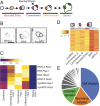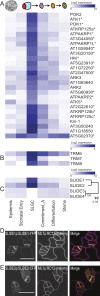Transcriptional profiling reveals signatures of latent developmental potential in Arabidopsis stomatal lineage ground cells
- PMID: 33875598
- PMCID: PMC8092560
- DOI: 10.1073/pnas.2021682118
Transcriptional profiling reveals signatures of latent developmental potential in Arabidopsis stomatal lineage ground cells
Abstract
In many developmental contexts, cell lineages have variable or flexible potency to self-renew. What drives a cell to exit from a proliferative state and begin differentiation, or to retain the capacity to divide days or years later is not clear. Here we exploit the mixed potential of the stomatal lineage ground cell (SLGC) in the Arabidopsis leaf epidermis as a model to explore how cells might balance potential to differentiate with a reentry into proliferation. By generating transcriptomes of fluorescence-activated cell sorting-isolated populations that combinatorically define SLGCs and integrating these data with other stomatal lineage datasets, we find that SLGCs appear poised between proliferation and endoreduplication. Furthermore, we found the RNA polymerase II-related mediator complex interactor DEK and the transcription factor MYB16 accumulate differentially in the stomatal lineage and influence the extent of cell proliferation during leaf development. These findings suggest that SLGC latent potential is maintained by poising of the cell cycle machinery, as well as general and site-specific gene-expression regulators.
Keywords: Arabidopsis; MYB16 endoreduplication; stomatal lineage ground cell; transcriptional profile.
Copyright © 2021 the Author(s). Published by PNAS.
Conflict of interest statement
The authors declare no competing interest.
Figures





Similar articles
-
Timely expression of the Arabidopsis stoma-fate master regulator MUTE is required for specification of other epidermal cell types.Plant J. 2013 Sep;75(5):808-22. doi: 10.1111/tpj.12244. Epub 2013 Jun 21. Plant J. 2013. PMID: 23662679
-
Lineage- and stage-specific expressed CYCD7;1 coordinates the single symmetric division that creates stomatal guard cells.Development. 2018 Mar 21;145(6):dev160671. doi: 10.1242/dev.160671. Development. 2018. PMID: 29467245 Free PMC article.
-
Multi-scale dynamics influence the division potential of stomatal lineage ground cells in Arabidopsis.Nat Commun. 2025 Mar 17;16(1):2612. doi: 10.1038/s41467-025-57730-9. Nat Commun. 2025. PMID: 40097420 Free PMC article.
-
Stomatal development in the context of epidermal tissues.Ann Bot. 2021 Jul 30;128(2):137-148. doi: 10.1093/aob/mcab052. Ann Bot. 2021. PMID: 33877316 Free PMC article. Review.
-
Establishing asymmetry: stomatal division and differentiation in plants.New Phytol. 2021 Oct;232(1):60-67. doi: 10.1111/nph.17613. Epub 2021 Aug 1. New Phytol. 2021. PMID: 34254322 Free PMC article. Review.
Cited by
-
Stomatal development and genetic expression in Arabidopsis thaliana L.Heliyon. 2021 Aug 27;7(8):e07889. doi: 10.1016/j.heliyon.2021.e07889. eCollection 2021 Aug. Heliyon. 2021. PMID: 34485750 Free PMC article. Review.
-
MYB16 expression in the stomatal lineage: Wrong place at the wrong time leads to stomata side-by-side.Plant Cell. 2022 Jan 20;34(1):8-9. doi: 10.1093/plcell/koab268. Plant Cell. 2022. PMID: 35226743 Free PMC article. No abstract available.
-
Experimental validation of the mechanism of stomatal development diversification.J Exp Bot. 2023 Sep 29;74(18):5667-5681. doi: 10.1093/jxb/erad279. J Exp Bot. 2023. PMID: 37555400 Free PMC article.
-
Promoters of ASCL1- and NEUROD1-dependent genes are specific targets of lurbinectedin in SCLC cells.EMBO Mol Med. 2022 Apr 7;14(4):e14841. doi: 10.15252/emmm.202114841. Epub 2022 Mar 9. EMBO Mol Med. 2022. PMID: 35263037 Free PMC article.
-
Overexpression of a Grape MYB Transcription Factor Gene VhMYB2 Increases Salinity and Drought Tolerance in Arabidopsis thaliana.Int J Mol Sci. 2023 Jun 28;24(13):10743. doi: 10.3390/ijms241310743. Int J Mol Sci. 2023. PMID: 37445921 Free PMC article.
References
Publication types
MeSH terms
Grants and funding
LinkOut - more resources
Full Text Sources
Other Literature Sources
Molecular Biology Databases
Miscellaneous

